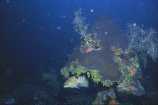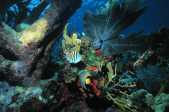

![]()
Have a Question or Comment?
What can we do to make this site more useful to you?
Note: Adobe Acrobat Reader required for PDF documents.
Problems accessing PDF documents?
Download the document to disk:
Mac Users: Option-click
PC users: Right-click
Last Updated 1/17/2006
Draft Revised Species List for the FKNMS
Calcium carbonate is produced by many marine plants and animals, including some species of algae and many marine invertebrates. These organisms use the calcium carbonate as a skeleton, either internally similar to a human skeleton or externally such as a snail shell. In any case, these skeletons of calcium carbonate mesh to form a rigid, wave resistant structure called a reef. When the primary reef-building organisms are corals of the phylogenetic order Scleractinia and certain algal species, the reef is called a coral reef. Colonies of tiny anemone-like polyps are the living coral tissue. Within the tissue of most reef-building corals live small organisms that are capable of photosynthesizing or changing light energy into food. These organisms are called zooxanthellae, pronounced zo-zan-thel-ee. Although corals are carnivorous and feed on zooplankton, they receive much of their energy and oxygen as byproducts of zooxanthellae photosynthesis. The zooxanthellae also promote the rate of calcium carbonate production by the coral colony, thus, promoting growth. The relationship between coral colonies and zooxanthellae is called symbiosis. This is a mutual relationship between species in which one or both benefit. Symbiotic relationships are common among organisms living on coral reefs. Coral reefs can be found in waters surrounding land masses that fit within a narrow range of physical parameters. Generally, reef-building corals are restricted to the tropics, the area between the Tropic of Cancer (23.5 degrees north latitude) and the Tropic of Capricorn (23.5 degrees south latitude). Tropical waters are generally warm, clear, low in nutrients, and have a stable temperature and salinity. (The list below gives the range of physical parameters under which reef development has been observed.) Ocean currents can alter the physical characteristics of an area reducing or expanding the area where reefs may develop. The Florida Keys is one example in which the warm waters of the Gulf Stream expand the range of corals north of the tropics. Physical Requirements of Coral Reefs
Seagrasses are flowering plants that live underwater. Like land plants, seagrasses produce oxygen. The depths at which seagrasses are found is limited by water clarity which determines the amount of light reaching the plant. Although seagrasses occur throughout the coastal waters of Florida, they are most abundant from Tarpon Springs northward to Alalachee Bay. Seagrasses also occur in protected bays and lagoons as well as along the continental shelf in the Gulf of Mexico. Florida's estimated 2.7 million acres of seagrass meadows are important natural resources that perform many significant functions including:
Seagrass leaves provide excellent protection for young marine animals from larger open-water predators. Some animals, including manatees, eat the seagrass blades. Still others derive nutrition from eating algae and small animals which colonize the seagrass leaves. The colonizing organisms provide an additional link in the marine food chain. |

